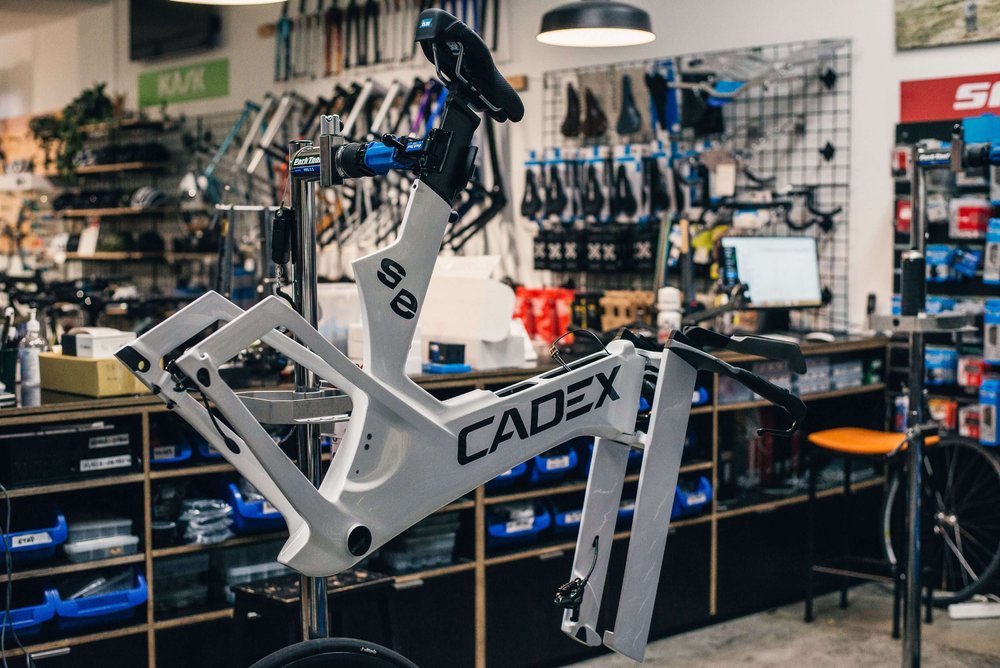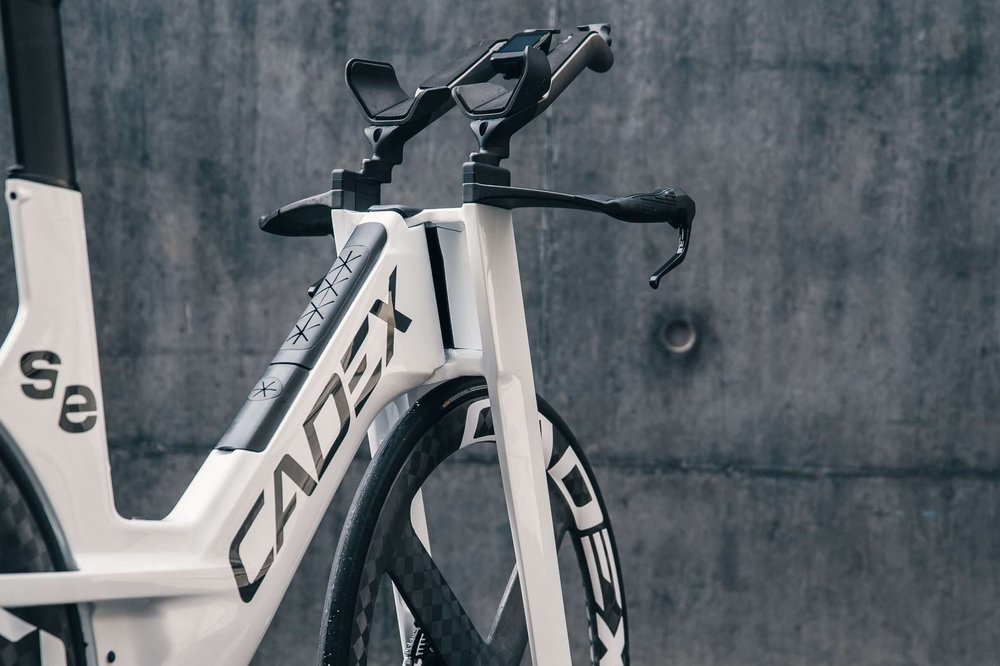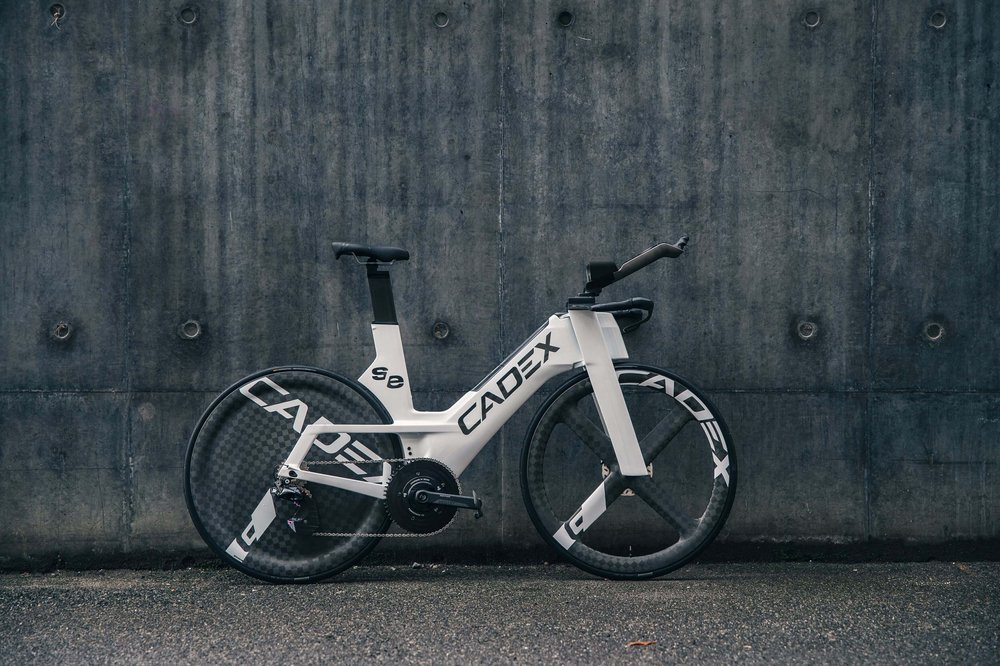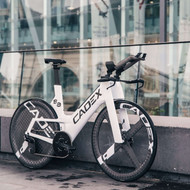The CADEX Tri
12th Jan 2024
Inspired by the Giant MCR of the 90's, the CADEX Tri Frameset is a unique bike, to say the least. Like many of the composite bikes of the 90’s, their success was limited by manufacturing techniques, weight and longevity – No matter how revolutionary the aero developments may have been, no one want’s to ride a bike that is profoundly heavy, doesn’t ride well and doesn’t last long. Fast forward 25 years and thankfully today is not in the 90's, design and manufacturing techniques have evolved the CADEX Tri is the new kid on the block in the triathlon world.
For this special custom build, we teamed up with Saint Cloud, to put together this unique machine.

The Build
The build process for Tri and TT bikes is typically an activity feared by most bicycle mechanics. CADEX have really taken this into consideration on the Tri frameset and implemented key features to enhance and streamline the build process. Internal cabling is easy with smart front end routing and access points, plus the super roomy frame body allows you to really get in there and work.
The complex looking front of the bike is easy to install with a simple 'preload and lock' system for the fork plus the base bar is easy to loosen, slide and fold down for packing with ease. All in all a relatively easy bike to put together. Thank you CADEX!

Prototype 1X Driveline
We get so many questions about this one, so we might as well answer them here. At Sync, we do see a useful application for a well-designed 1X setup. The caveat here being - WELL DESIGNED, as unfortunately, many are simply not.
One of the most relevant design parameters is the chainline, which is required to see use of the full range of gears and to achieve an optimal chainline in the primary race gears. Most options on the market are simply a flat chainring, bolted on in place of the large chainring. This provides a chainline that will closely match what was intended on the original crankset and results in severe cross-chaining (and high-risk of chain drop) in the upper end of the cassette.
Second to this, the need for a tooth design that facilitates chain retention, especially when using gears at the extremes of the cassette. Of course, a chain catcher is also a good idea, but this doesn’t make up for a well-designed tooth profile in the first instance.
Our solution? Adjustment of the chainline, allowing for the use of all cogs on the cassette. To do this, on our prototype setup, we have been using a power2max track spider, on the Rotor road spindle. This delivers a standard road Q-factor, but a narrower (track) chainline. The rings we have been using for this exercise are made by Garbaruk, with a unique tooth profile that is by far, the most secure and robust, of the 1X designs we have seen to date.

Sync EVO PRO Cockpit
Offering an EVO solution for the CADEX Tri has been on our agenda since the release of the bike and we now have a solution for this, allowing for uncompromised setup options on the CADEX Tri.
The EVO PRO is a high-performance, modular design, CNC machined and 3D Printed Titanium TT extensions that are developed with nine different setup configurations to optimise aerodynamic performance.
Along with our 3D Printed Ti extensions, the EVO PRO features 3D Printed Deep Groove Performance arm cups, a build-specific computer mount and our infamous hooked lug grips.

Modern-day Triathlon Demands
Getting from T1 to T2 in the shortest possible time requires maximum output (speed) for the rider’s input (power output), this efficiency coming primarily from the athlete’s position on the bike (aerodynamic efficiency). For even modest pace, around 90% of resistance to forward motion is in the form of aerodynamic drag, and about 10% is in the form of mechanical resistance. Of this, about 70% of resistance is attributed to airflow over the athlete, 30% is attributed to airflow over the bike. In other words, a bike needs to be aero, it needs to cater for the nutrition requirements of the athlete (inc hydration), it needs storage provisions and most importantly, it needs to facilitate the achievement of an aero cycling position.

Aero Wheelsystem
This is a complex package that encompasses far more than simply the wheel and requires a system wide approach to achieving the most balanced design. Bringing this back to the basics, it’s about rolling resistance, a factor in the mechanical resistance to forward motion.
Ceramic bearings help in reducing friction, but so does the precision machining of the bores in the hub shells, an often overlooked factor in rolling resistance. The interaction between the tyre and the rim is relevant for both aero performance, but also controlling the deformation of the tyre as it is weighted while riding. The design of the rim is favourable to certain types of tyres, which of course, all have their own unique rolling qualities. Then, of course, there is the aero component, with airflow over the wheel and the interaction between the wheel and the bike.
Addressing all of these design considerations really comes from CADEX “owning” the whole package and hats off to the team for producing a great Wheelsystem.

Credits
Images by @benxlehner
Copy by @saintcloudbikes and @ridesync
About the shop
Saint Cloud is a friendly bike shop in downtown Fitzroy, Melbourne, AUS.
We are strong believers in supporting and endorsing unique and exclusive bicycle products on a local and international level.
Sync Ergonomics has been supplying Saint Cloud with ergonomic cockpit solutions from the first days of our existence and we continue to share a customer base and collaborate on exciting builds. This CADEX Tri is one fine example.


